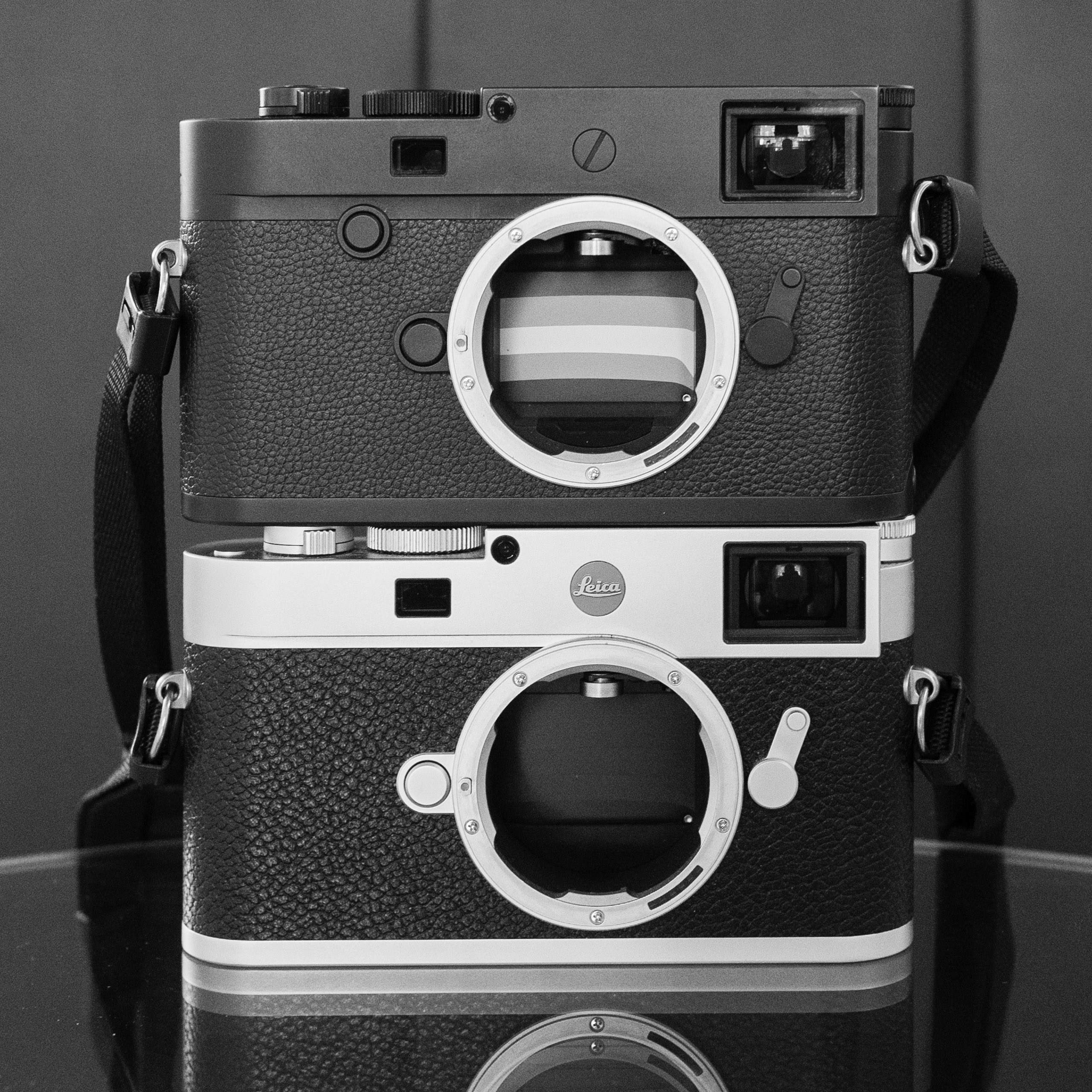First of all, so that we don’t misunderstand each other: The Leica M11 is a great camera. I’ve been using it for half a year now for all kinds of different occasions. It is ideally suited for my needs. Not once have I felt that it was not up to the job.
The developers have managed to combine the traditional values of rangefinder photography with the demands of sensor performance and connectivity.

Open and shutter
Before anyone thinks a Leica marketing-generated bot wrote this article, I’m afraid I have to a liberal splash from a bucket of cold water: I consider the fact that the shutter is permanently open after switching on the camera to be unnecessarily wasted potential and in some respects detrimental. The argument that every mirrorless camera works like this doesn’t really hold water because the M-Leicas, unlike the others, have an optical viewfinder that doesn’t need the sensor for “seeing the subject“, as Sean Reid puts it.
I imagine that at some point in the development phase there was a team meeting where a faction of “modernists” declared the old exposure metering method antiquated and inaccurate.
Were all the trolls who claimed the same thing when I was still shooting with the M9 right after all? Or had some of them sneaked undercover into the development department?

No idea, but in any case the M11 lacks the necessary hardware for the traditional rangefinder mode. Now it looks like this: The shutter opens, and the exposure is measured by the sensor. The shutter closes again for the photo, then opens/closes for the actual exposure and — tadaa: opens again. Four times for each picture.
But even if the shutter still holds for mega-long, the sensor only consumes a fraction of the energy when the monitor is switched off and the shutter lag is extended only by imperceptible hundredths of a second (I never lost a shot because of this): The sensor is constantly exposed, the forces of darkness are advancing and even the thundering words “thou shalt not pass!” (with apologies to Gandalf) are of no use. Dust is the enemy, creeping and cunning, not a Balrog.
Dear Herr Daniel…
No reason to throw in the towel. Instead, I wrote an email to Wetzlar.
If there is one face that I associate with Leica, it is that of Stefan Daniel (sorry, Dr K.), who has worked his way through the ranks of the company from the ground up and has an open ear, especially for the needs of M users. The email was addressed to him.
I described my concerns to him, together with a suggestion:
If the shutter closes automatically as soon as the lens is removed, that might help. Of course, one could also remember to switch off the camera before changing lenses. But, as the saying goes “the problem is usually behind the camera”, and to be protected from one’s own stupidity, this addition to the firmware would be helpful.
The very next day I got an answer. Summarising „das Wesentliche“ (pun intended):
He confirmed that they had not made the decision to drop the classic rangefinder mode lightly. Unfortunately, the camera could not be redesigned now (which was clear). But my message was an incentive to think about how the situation could be improved.
The suggestion that the shutter closes automatically when the lens is changed would definitely be looked into.
And that’s Leica for you. The answer is not meant in a non-committal way, I really have the feeling that I am being taken seriously. There are people behind it who communicate with users at eye level.
I will definitely take up Stefan Daniel’s invitation for coffee the next time I am in Wetzlar. Something else regarding the M11 occurred to me…
You can read this article in German on Claus Sassenberg’s excellent Messsucherwelt.com blog.
A cup of coffee works wonders in supporting Macfilos
Did you know that Macfilos is run by a dedicated team of volunteers? We rely on donations to help pay our running costs. And even the cost of a cup of coffee will do wonders for our energy levels.


It would have been nice to have a menu option to choose between the traditional centre-weighted measurement, or the new sensor based multi-field measurement with shutter always open. That would have made the camera (even) slightly more expensive, as the metering cell at the bottom of the camera body would then have remained necessary. But in that case, I personally would probably have continued using the traditional metering.
I would also like you to ask Stephan to also stop the embellished marketing that the SL f/2 APO primes have the same depth of field as a f/1.4 prime. The Peter Karbe graph comparing the depth of field of a prehistoric 1980 Summilux 75/1.4 to a sensational current state-of-the art design SL 75/2 apo is incompetent at best and deliberately misleading at worst. This mistruth then gets passed on that the SL APO 50mm f/2 and other APO primes have a depth of field similar to the f/1.4. I once saw a professional photographer compare the out of focus rendering of the new Sigma 85/1.4 to the Leica SL 90mm APO f/2 and the Sigma 85/1.4 out of focus rendering was obviously smoother. However, the Leica 90mm is technically superior in a number of other ways such as distortion.
It has always bothered me that Leica never compared the bokeh of current f/2 and f/1.4 lenses with real images. The proof is showing the depth of field comparison with real subjects. There is also the difficult issue of how busy backgrounds appear and point light sources at various distances and so on.
As an engineer, I know graphs are only as good as the model put into the computer. The real proof is in image comparison with various subjects.
i purchased the SL APO 50mm f/2 a few months ago and it was readily clear to me that my Panasonic S 50mm /1.4 that I owned had a smoother painterly out of focus rendering. I had sold it long ago due to health issues. I had to prove my suspicions and just purchased the sensational Leica SL 50/1.4 lens. I took it and the sensational Leica APO SL 50mm f/2 out for an extensive comparison shoot yesterday at their wide open aperture. The difference was so obvious that I could see the difference in the viewfinder for most images. I am going to write an article on this but it will probably take me awhile as I am not blessed with verbal diarrhea like the many great writers on this blog.
The Leica 50/2 is technically better in a few areas such as focus speed and sharpness to the corners (the 50/1.4 never gets sharp in the extreme corners but I can prune that if necessary, and it is a lot bigger and heavier) but the 50/1.4 is clearly the bokeh master. Hence, my magnificent SL 50/2 is going to be put up for adoption on ebay shortly.
verbal diarrhea 😂
Claus, you really need to ease up on the Leica Kool Aid. I love Leicas -I have been using them for nearly 60 years -but when it comes to listening to their customers nowadays they have poor or very selective hearing.
If you had owned an X1 or an X Vario ( and presumably an X2) you would know all about the very fragile battery retaining clip. I have had mine on my X1 and XV replaced 4 times. The issue was very well known. All the replacements under warranty must have cost Leica tens of thousands, perhaps even hundreds of thousands, of Euros. Despite the cost and the inconvenience to owners Leica did nothing to redesign or respecify the clip. And we are not talking advanced optical or electronic engineering here we are talking about a very small plastic clip.
The evil floating focus point in the Q and now Q2 drives me and many others-including editor Mike- to distraction. Yet despite all the feedback on forums and in reviews Leica remain deaf to the problem which surely could be fixed with a simple software tweek?
My suggestion to Stefan Daniel is before exercising your mind on an esoteric issue with the M11 perhaps you could prompt whichever department is responsible to fix the Q/Q2 floating focus point issue. In terms of generating customer relations brownie points that fix would win quite a few.
Sadly the damage has been done with the X battery retaining clip issue-too late to fix that one.
That retaining clip issue (which I think also plagues the X and X-Vario) is a good example of inaction in the face of a simple mechanical problem that ought to have been solved. It reminds me of my experience with the Jaguar I-Pace. A great car to drive, but let down by a toy-town charging port mechanism which damaged the reliability of the entire car. It should have been easy to fix but it wasn’t done.
The floating focus point is an example of a different kind: bloody mindedness because, I hear, the factory thinks users should be educated not to use a fixed central focus point. Get modern, they say. The fact that most other manufacturers of mirrorless cameras do include a focus-point lock in the menu is immaterial.
That said, we shouldn’t ignore new problems just because of past inaction on older issues. I’ve also noticed the issue Claus raises and, by all accounts, Stefan Daniel acknowledges that it was a tough decision to go with the new setup. It’s a good subject for discussion, I suppose, and maybe this time the factory will listen. But, as Stefan says, it’s too late for the M11 which cannot now be redesigned.
Non-committal like APS-C is a part of Leica’s product range and will continue…? No offense but I would attach very little importance to words coming out of Stefan Daniel’s mouth…
No offense to anyone but sounds like corp speak on why nothing got done on wandering focus!
Wouldn’t have happened in the film days? Just to get this right, does the shutter close when you switch off the camera? The general advice with battery fed cameras is that they should be powered off when attaching lenses or other accessories. One important one is with flash guns which should also be powered off themselves when they are attached. This open sensor thing must also apply when using an external EVF with an M10 or M240. I imagine that the design concept in the M11 is a step on the highway towards an ‘EVF included’ M camera and that the current M11 design represents ‘thinking ahead’.
I should be seeing Stefan in Wetzlar later this week and I will ask him about this. I will be there mainly to see old film cameras being auctioned, of course. The principal item in the auction is a 0 Series camera used by Barnack. That camera required the user to put the lens cap on, as the camera was being wound on, in order to avoid the film being exposed. This was later resolved by the self capping shutter. What you seem to want is a self capping shutter for the M11.
What comes around, etc. There really is nothing new under the sun!
William
Dear William,
when the camera is switched off, the shutter closes, so it would already be helpful to think about this yourself before changing lenses. But in the heat of the moment, you sometimes miss it.
That’s why it would be good if the camera did that.
If you see Stefan Daniel, feel free to ask him about it.
By the way, he said in an interview with the Swiss website fotointern.ch that as long as he had a say at Leica, there would be no M with EVF.
Best,
Claus